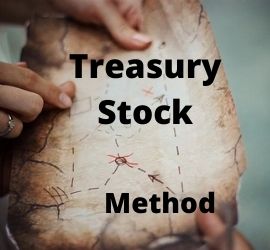What Is the Treasury Stock Method?
 The Treasury stock method is used to compute the number of new company shares that can be created from existing in-the-money warrants or options.
The Treasury stock method is used to compute the number of new company shares that can be created from existing in-the-money warrants or options.
The treasury stock method is an accounting procedure. Companies use it to compute the number of new shares they can potentially create if they exercised in-the-money warrants and options. This only matters when the exercise price is less than the current share price. Potential shares obtained through the treasury stock method factor into the calculation of the diluted earnings per share (EPS).
The treasury stock method assumes that the money obtained by the company from exercising in-the-money options is used for stock repurchases. Repurchasing those shares turns them into treasury stock. This is where the method gets its name.
Treasury Stock Method – A Closer Look
Generally accepted accounting principles (GAAP) advise that the treasury stock method should be used by a company when computing its diluted earnings per share (EPS). To comply, the basic share count is used in calculating a company’s earnings per share. However, the share count must be increased as a result of outstanding in-the-money options and warrants. These options and warrants entitle their holders to purchase common shares. In-the-money means the exercise price is below the current market price.
- Net income – There is no adjustment to the net income in the numerator.
- Exercise price – Upon exercise of the options or warrants, the company receives the following amount of proceeds: (exercise price of the option) x (number of shares issued) to holders of the options or stock warrants.
- Buyback Shares – The company will then use the proceeds from the exercise of options and warrants to buy back common shares at the average market price for the year.
- Adjusted outstanding shares – The net change in the number of shares outstanding is the number of shares issued to holders of the options or warrants less the number of shares acquired from the market.
Treasury Stock Method and GAAP
Generally accepted accounting principles (GAAP) standardizes how a company keeps its books. As a result, when an investor considers purchasing security from that company, the public information on the corporation is based on standardized accounting methods. It gives investors a better vantage for comparing apples to apples. There are terms to understand before looking closely at the treasury stock method:
Earnings Per Share
Earnings per share is a ratio of how much of a company’s profit is allocated to its shareholders in a given period of time. It is simply calculated – Net Income – Dividends / Average Outstanding Shares. The number of shares outstanding can change for any corporation over time. For example, it occurs when the company issues additional shares or repurchases common shares back from the public. Earnings per share is an indicator of company performance. It is often used as a tool for evaluating the success of a particular company over a given period of time. Higher earnings per share are better than lower earnings per share.
Diluted Earnings Per Share
Earnings per share do not account for outstanding convertible securities. For example, employee stock options may be outstanding or on the market at any given time. Additionally, there may be convertible preferred shares, employee-based stock options, or warrants on the company’s securities. These can remain floating around the market, but as yet, unexercised. It is very rare for a publicly-traded company to have zero convertible securities outstanding. These outstanding securities could potentially dilute the reported earnings per share. This information is of interest to investors and shareholders. It turns out diluted earnings per share can be much lower than standard earnings per share. As a result, the diluted model takes into account the fact there are many more potential outstanding shares on the market. shares that could be exercised at any moment are calculated and the information is made available to shareholders.
Treasury Stock Method Formula
Additional shares outstanding = Shares from exercise – repurchased shares
Additional shares outstanding = s (1 – X/P)
- s = in-the-money shares from options or warrants that are exercised
- X = average share price when exercised
- P = average share price for the period
Example of Treasury Stock Method
For example, a company has an outstanding total of in-the-money options and warrants for 25,000 shares. The exercise price of each of these options is $8. However, the average market price for the reporting period is $12. Assuming all the options and warrants outstanding are exercised, the company will generate 25,000 x $8 = $200,000 in proceeds. Using these proceeds, the company can buy $200,000 / $12 = 16,667 shares at the average market price. Thus, the net increase in shares outstanding is 25,000 – 16,667 = 8,333.
- s = 25,000 – in-the-money shares from options or warrants that are exercised
- X = $8 – Average share price when exercised
- P = $12 – Average share price for the period 16,666
This can also be found by simply using the formula provided above. The net increase in shares outstanding is: 25,000 (1 – 8/12) = 8,333.
What are Common Stock Options for Employees and Management?
In most annual reports investors may come across different types of stock options. The common ones are employee stock options, Restricted Stock Shares, Performance Stock Shares. There are other less common types as well. This is by no means a comprehensive list.
- Employee Stock Options – ESOs typically represent the options offered by a company to individuals as a part of their equity compensation plans. These are usually reported by companies with details like issue date, exercise date, and exercise price. These are issued to encourage employees to remain with the company for long periods of time. ESOs usually are issued with a stated vesting period. Also, they can not be exercised until the stock price of the company trades above the exercise price.
- Restricted Stock Shares – Restricted Shares entitle individuals to ownership rights to a company’s stock. These are subject to restrictions, hence the name. Restrictions typically include limits regarding when the stock or option is considered fully vested and can be sold. The vesting event is determined by minimum service or performance conditions set by the company. Often, during the restricted period, the individuals may have voting rights and the right to the dividends owed to restricted shares.
- Performance Stock Shares – Performance Stock Shares are restricted stock shares that vest upon the achievement of performance conditions specified by the company. These shares are generally subject to sale restrictions and risk of forfeiture until a specific performance measurement is satisfied. During the restricted period, they may carry voting rights and the right to dividends paid on the restricted shares. If dividends are allowed, they may be paid in cash or reinvested in additional performance shares. Once vested, the performance shares are usually no longer subject to restriction.
When to Use the Treasury Stock Method
This is a required calculation for publicly-held companies. Generally accepted accounting principles (GAAP) require all public entities to report their diluted earnings per share on the face of the income statement. The only exception is when a business has such a simple capital structure that the diluted earnings per share figures are the same as its basic earnings per share.
The treasury stock method is the accepted way for companies to calculate how many additional shares may be generated from outstanding in-the-money warrants and options. The new additional shares are then used in calculating the company’s diluted earnings per share. As a result, EPS is diluted due to outstanding in-the-money options.
Up Next: GWACs – What are Government-Wide Acquisition Contracts?
 GWACs are government-wide acquisition contracts. They let government agencies align their needs and jointly purchase contracts for goods and services.
GWACs are government-wide acquisition contracts. They let government agencies align their needs and jointly purchase contracts for goods and services.
With GWACs, multiple government agencies can align their needs and purchase a contract for goods or services. As a result, GWACs allow for economies of scale which are intended to reduce per-unit costs. A government-wide acquisition contract consolidates purchases as opposed to having each agency enter into an individual contract.




